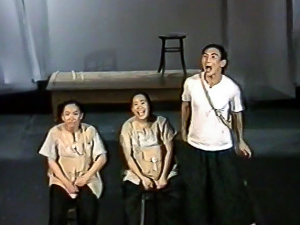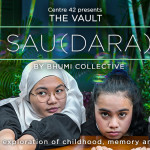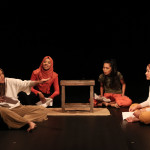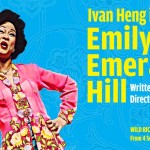
A scene from the recording of Three Children (1988) by TheatreWorks.
(L to R) Claire Wong, Lok Meng Chue, Lim Kay Tong
Click to watch snippets of the recording on TheatreWorks’ YouTube channel.
Synopsis
Three Children is about three grown-up siblings – two sisters and a brother – returning to their childhood home on Kappan Road in Malacca. There is no linear narrative in the play. Instead, the three characters (and a narrator) race through a mindboggling series of children’s songs, games and sketches.
Earlier Incarnations
Leow Puay Tin wrote Three Children in 1985 during a playwriting course, basing the play on her own formative years growing up on Kappan Road. At the time, the Malaysian actor-writer was well-known for having originated the role of Emily Gan in Stella Kon’s Emily of Emerald Hill in 1984. But she had also written four short plays, including Three Children, by this point.
Three Children was first staged on 1 September 1987 in a free lunch-time performance at the Shell Theatrette at Raffles Place. This early incarnation of Three Children was performed by the Malaysian theatre collective Shell KL Drama Group, and directed by Chin San Sooi from Kuala Lumpur-based theatre company Five Arts Centre.
The 1987 production of Three Children was not received well. Business Times theatre critic Jamie Lye reported audience members walking out in the middle of the performance. Writing about the play in verse in mockery of the play’s lyrical text, Lye said: “Full of abstract notions/That did not stir emotions/Just a lot of stylish lingo/And a plot that stayed in limbo”.
The next time Three Children saw the stage was on 7 July 1988 at the Experimental Theatre in Universiti Malaya, Kuala Lumpur, performed as part of a double bill with another of Leow’s plays, Two Grandmothers. Chin directed the production, and Leow herself performed as one of the sisters.
The Singapore-Malaysia Collaboration
In 1988, Malaysian theatre doyen Krishen Jit met Ong Keng Sen, who had recently become Artistic Director of Singapore theatre company TheatreWorks, after the former penned a review about the TheatreWorks musical Beauty World. It was this meeting – at Hilton Hotel Coffeehouse, according to From Identity to Mondialisation – which sparked off a formal creative exchange between Krishen’s company Five Arts Centre in Kuala Lumpur and TheatreWorks in Singapore.
For Ong, the collaboration was a turning point for TheatreWorks. About the new direction the local company was embarking on, Straits Times reporter Judith Holmberg wrote: “There are some who describe the change in gear as much-needed, citing that the group has been losing its impetus, sliding away from its original goals and becoming predictable in its presentations.”
As a first project in the cross-Causeway exchange, Ong and Krishen would co-direct a TheatreWorks production of Three Children. Work on the play would begin in September 1988.
Creating “Three Children”
Actors Lok Meng Chue, Claire Wong and Lim Kay Tong were cast as the three sibilings, and Neo Swee Lin would play the narrator. Work on the TheatreWorks production started three months before its November opening. Krishen travelled to Singapore on weekends to work with the cast.
While Leow had re-written her play, the actors were not allowed to look at the script for most of the rehearsal period. Instead, Krishen led the actors through devising sessions, a creative process completely new to them. Wong said, “He started by feeding us lines, then bare outlines of situations and said: ‘Do what you can with it.’ We weren’t sure where were heading. He just kept saying: ‘It’s got to come from within!’ He wanted us to use our whole bodies, to tap whatever resources we had, not just our faces or voices.”
In the 1992 programme of Three Children, co-director Ong echoed: “One thing we were very clear of: the final production of Three Children would spring from the imaginations of the actors themselves. The actors would build the world of these 3 children, viewed through children’s eyes. The directors would act as catalysts, pushing them to explore and confront themselves. The whole process was built on experience, memories; felt by the body rather than rationalised by the mind.”
Looking back on the rehearsal process for Three Children, Lok commented, “Everything was so abstract, we had nothing to hold on to.”
On top of devising, the actors were put through rigorous skills training. A voice teacher, as well as a taichi instructor and a Chinese opera expert were brought in to train the actors. According to Krishen, “Good acting means using the right techniques, and you have to learn the techniques before you can use them.”
Taichi and Chinese opera would make their way into the production as well, evincing Ong’s desire for intercultural theatre in Singapore. Ong said, “The English-language drama scene here has no history. Theatre groups have ignored Asian theatre as if we’re living in a desert, when the fusion between East and West should work particularly here.”
The TheatreWorks production of Three Children premiered on 11 November 1988 at the Drama Centre.
Responses to “Three Children”
The 1988 production of Three Children was critically lauded in spite of being a challenge for both actors and audience.
Adeline Woon of the New Paper commended the cast’s performances, noting the excellent vocals and facial experiences, as well as the influence of taichi on the fluid body movements onstage. In sum, she wrote, “The play is as demanding on the audience as it is on the actors. It needs concentration to follow a play that has no plot but switches from one little story to another. But it is well worth the effort.”
T. Sasitharan, writing for the Straits Times, was effulsive in his praise for the production. He wrote, “Suddenly it transpires that a tale is unfolding. At times it is banal, sometimes bizarre, but it is imperative that you watch […] Soon, too soon, it is over; only resonances linger, an afterglow of dreams.”
Jamie Lye, who reviewed the 1987 performance by the Shell KL Drama Group, still thought Leow’s play was “self-indulgent” and headache-inducing. But, she was impressed by the actors’ performances and the directorial vision of the production: “Theatrework’s production of 3 Children was a dramatic masterpiece – a milestone production for the company.”
TheatreWorks re-mounted Three Children as a touring production in 1992, with Krishen and Ong returning as co-directors. Lok and Wong also returned to perform, with Loong Seng Onn taking on the male lead and Tan Kheng Hua assuming the role of narrator. The 1992 production was staged in Singapore, Malaysia and Japan.
By Daniel Teo
Published on 27 September 2018
References
Koh, B. P. (2013). From Identity to Mondialisation: TheatreWorks 25. Singapore: TheatreWorks.
Rowland, K. (Ed.) (2015). Staging History: Selected plays from Five Arts Centre Malaysia 1984-2014. Malaysia: Five Arts Centre.
Three Children. (1992). House programme.
.
The Vault: Sau(dara) is a contemporary response to Leow Puay Tin’s Three Children. Created by Bhumi Collective, Sau(dara) is an homage to the 1988 production of Three Children which draws from the original text and the performers’ childhood memories, is based on play and traditional Indonesian Pakarena dance, and features newly-composed music. Find out more here.






